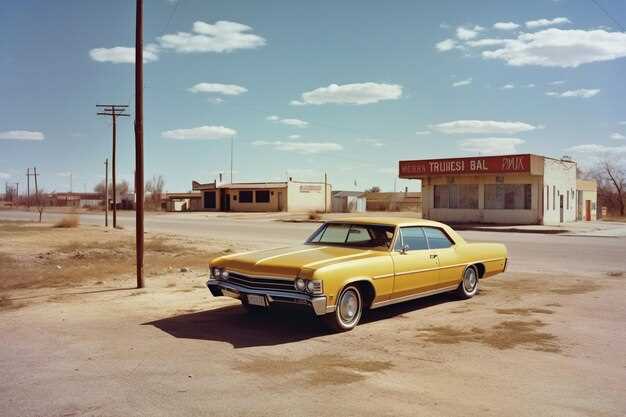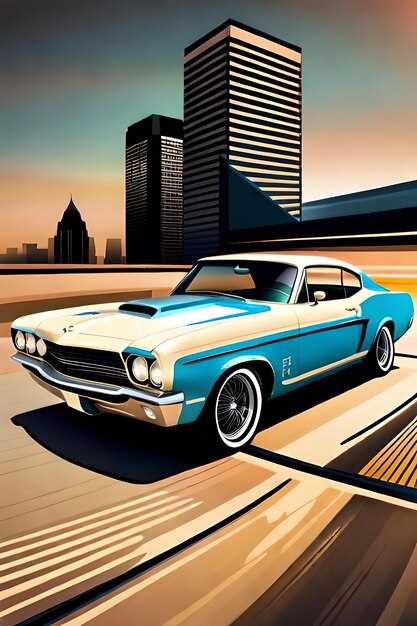
The 1970s marked a pivotal era in automotive history, characterized by a fierce rivalry between two American muscle car icons: the Chevrolet Camaro and the Ford Mustang. This competition not only captured the hearts of car enthusiasts but also defined an entire generation’s approach to speed, style, and performance.
The Mustang quickly established itself as a cultural phenomenon. Launched in the mid-1960s, it redefined the notion of the “pony car” and gained a loyal following thanks to its innovative design and exhilarating performance. In the following decade, Ford continually pushed the boundaries, introducing high-performance variants that captivated driving enthusiasts.
On the other side of the divide, the Chevrolet Camaro emerged in 1966 as a direct answer to the Mustang. With its aggressive styling and customizable options, the Camaro quickly gained traction among those seeking a thrilling driving experience. The car’s powerful engines and precise handling made it a formidable competitor in the muscle car arena.
This article delves into the intricacies of the Mustang and Camaro rivalry during the 1970s, analyzing how each vehicle not only competed for market dominance but also reflected the changing cultural landscape of America. From street races to showrooms, the clash between these two powerhouses remains a fascinating chapter in the story of American automobiles.
Performance Specs: Comparing Engine Power and Torque

When it comes to the iconic rivalry between the Camaro and the Mustang, performance specifications play a crucial role in defining their strengths. In the 1970s, both models were equipped with a range of powerful engines that established their reputation on the streets.
The Mustang, particularly the 1970 model, showcased a variety of engine options, including the 351 Cleveland V8 that produced around 300 horsepower and 380 lb-ft of torque. For enthusiasts seeking even more power, the 429 Cobra Jet variant was available, delivering an impressive 370 horsepower and 450 lb-ft of torque, making it one of the most potent options of its time.
On the other hand, the Camaro also offered formidable performance with its array of engines. The 1970 Chevrolet Camaro SS, for instance, featured the iconic 396 V8 engine, which generated 375 horsepower and 420 lb-ft of torque. This made the Camaro a fierce contender, matching the Mustang’s power levels while delivering an exhilarating driving experience.
Comparing these specifications reveals the competitive nature of both vehicles. The Mustang’s emphasis on high torque figures gave it an edge in acceleration, while the Camaro’s high horsepower ratings made it equally appealing for those seeking speed. This ongoing battle between engine configurations and performance metrics has made the 70s rivalry memorable among car enthusiasts.
Ultimately, the choice between Camaro and Mustang boiled down to personal preference regarding style, handling, and the emotional experience of driving. However, in terms of engine power and torque, both icons of American muscle were engineered to impress and leave an indelible mark on automotive history.
Design Features: Analyzing Body Styles and Aesthetics

The Ford Mustang and Chevrolet Camaro each boast distinct design elements that reflect their unique identities and the spirit of the 1970s American muscle car scene. The Mustang, introduced in 1964, set the standard with its long hood and short rear deck proportions. This classic silhouette, coupled with a variety of trim options and colors, allowed the Mustang to appeal to a broad audience, emphasizing both performance and style.
In terms of body styles, the Mustang offered a range of configurations, including the hardtop, fastback, and convertible, catering to different preferences and lifestyles. The fastback variant, in particular, showcased a sleek roofline that not only improved aerodynamics but also conveyed a sense of speed and sportiness. Chrome accents and bold front grilles contributed to its aggressive stance, while the distinctive horse emblem became synonymous with the brand’s identity.
On the other hand, the Chevrolet Camaro made its debut in 1966 as a direct competitor, presenting a more muscular and aggressive design approach. The Camaro featured a broader stance and a shorter wheelbase, lending it a stockier look compared to the Mustang. Its prominent split front grille, sharp lines, and pronounced fenders signaled a focus on performance and power. The incorporation of features like quad headlights and a rear spoiler in later models further emphasized its racing pedigree and aggressive aesthetic.
Both vehicles showcased a variety of paint options and graphic packages, allowing for personal expression among enthusiasts. Customization played a key role in the allure of these cars, as modifications in styling became common among fans. The Mustang’s classic and timeless appeal contrasted with the Camaro’s bold and assertive design, creating a rivalry that was as much about aesthetics as it was about performance.
In summary, the design features of the Mustang and Camaro underscore their respective philosophies. The Mustang embodies a sense of classic Americana with its elegant lines and versatility, while the Camaro channels raw power and aggressive styling. These differences have not only defined their rivalry throughout the years but also established their lasting legacies in automotive history.
Cultural Impact: Understanding their Influence on Car Enthusiasts
The rivalry between the Camaro and Mustang has transcended mere competition; it has shaped automotive culture in profound ways. These two icons from the 1970s have become symbols of freedom, rebellion, and individuality for countless enthusiasts. With their powerful engines and striking designs, both cars have sparked a passionate following that continues to thrive.
Community Identity: The Camaro and Mustang each foster distinct communities. Owners often participate in local car clubs, events, and shows, where they celebrate their vehicles and share experiences. This sense of belonging amplifies the connection enthusiasts have with their cars, creating lifelong friendships and networks that span generations.
Media Representation: The cultural significance of both the Camaro and Mustang is evident in their portrayal in movies, television shows, and music. These vehicles have become synonymous with American muscle, featured prominently in films like “Bullitt” and “Transformers.” Such appearances reinforce their status as cultural icons, attracting new fans and inspiring future generations of car lovers.
Customization and Personalization: The rivalry has encouraged a vibrant culture of customization. Enthusiasts often modify their Camaros to reflect their unique personalities, whether it involves performance upgrades or aesthetic changes. This creativity fosters innovation within the automotive community, as owners push the limits of what is possible with these iconic machines.
Iconic Status: The Camaro and Mustang are intrinsically linked to notions of Americana. They embody the spirit of the open road and the thrill of driving. As such, they have become a touchstone for automotive enthusiasts who appreciate the blend of nostalgia, performance, and style. The emotional connection people have with these vehicles solidifies their legendary status, ensuring that they remain influential in the automotive landscape.
Ultimately, the cultural impact of the Camaro and Mustang extends far beyond their capabilities as cars. They represent freedom, innovation, and passion, continuing to inspire car enthusiasts around the world.












